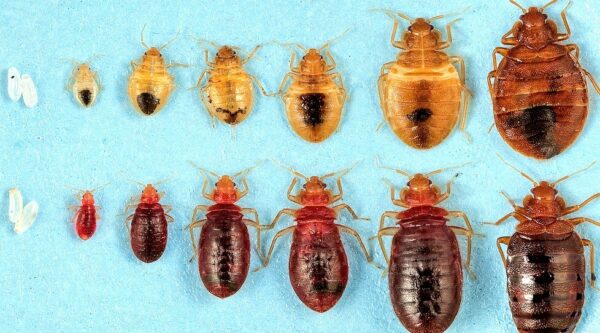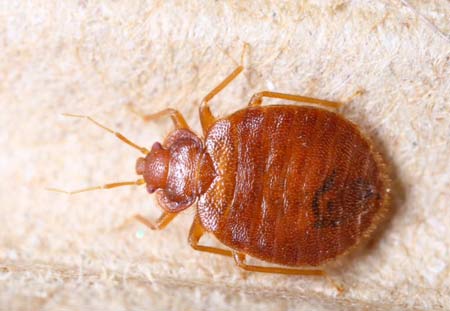Affordable Bed Bug Exterminator
Bed Bug Inspection
- Find Out If There Are Visible Signs Of Bed Bugs
- Locate Areas Of Activity In All Of Your Rooms
Bed Bug Treatments
- Initial Service & Inspections Every Two Weeks Until They Are Gone
- Impeccable 60 Day Warranty
1 Bedroom Treatments start at 550$ plus tax.
2 Bedroom Treatments start at 800$ plus tax.
3+ Bedrooms need to be quoted during the inspection.
We price per bedroom that bed bugs were found in, not by how many rooms are in the house.
*Prices are valid for single-family homes within 15 miles of our office location.
We are the only 5-star rated bed bug exterminator in Cleveland, with over 500 Google reviews.

Free Bed Bug Consultation
If you suspect you have a bed bug infestation, contact us by phone or email straightaway. You will need to provide us with all of the details.
 Have you found any live bed bugs? Or are you do you have bites?
Have you found any live bed bugs? Or are you do you have bites?- Have you saved any bed bugs in Ziploc bags or jars? Do you have pictures of any of the evidence?
- If so, send “detailed” close-up pictures to lakewoodexterminating@gmail.com.
- Do you rent or own the home? If you are a renter, skip to the next section, “Rental Properties With Bed Bugs.”
- How many rooms are affected? How many bedrooms in the home are slept in regularly?
- What size beds are in each room? Do the beds have box springs? Are they split or one-piece box springs?
- How long has this been going on for? What chemicals, if any, have been applied?
- Is it a single-family home or a multi-family dwelling?
- If it is a multi-family dwelling, have the adjacent units been checked?
Let us consult you on our recommendations that are unique to your situation. Contact us by phone with these details or use the contact form. Once we perform the consultation, we will know if we are a good fit. If our bed bug exterminators can help, we will visit your home for a paid inspection.
Bed Bug Inspections

All Life Stages Of Bed Bugs Are Visible To The Naked Eye.
Get your home inspected for bed bugs. We must find a live bed bug to schedule an exterminating service. If you have already found a live bed bug, please take a picture or save it in a bag. We cannot treat your home based on bites alone!
Our pest inspectors know just where to look for bed bugs. We will inspect any problem areas. These are generally within 5 feet of the occupants’ resting areas. So the couches, chairs and beds. Since we cannot sell you service unless we find a bed bug, we will provide a thorough and detailed inspection.
This is also a good time to go over preparation for exterminating the bed bugs. We will tell you the service details and how to prepare your home.
To control bed bugs long-term, stop introducing them into the home. During the visit, we will also review how they could have been brought into the home and what can be done to keep the problem from reoccurring. Education is a very important part of the exterminating process.
Preparation for Service
A customer must perform a certain level of preparation to make the treatment go smoothly.
You will achieve greater control when the site is properly prepared for treatment. Open the toggle below to read more. Then, click the button to download our bed bug preparation guidelines. Print them out for yourself or provide them to your tenants.
Learn More About Bed Bugs In Cleveland, Ohio

Bed Bugs: Identification & Life Cycle
Bed Bugs in Ohio - Information and FactsBed Bugs Infesting Cleveland, OhioCleveland, Ohio, has repeatedly been ranked near the top of the list of most bed bug-populated cities in the United States. In the 2023 and 2024 reports, Orkin ranked Cleveland/ Akron the 4th worst bed bug city. What does this mean? Probably is a tell-tale sign that we need to learn more about this troublesome pest.What Type Of Insect Are Bed Bugs?Bed bugs are categorized within the Order Hemiptera. This is the order of true bugs. While this does not mean much to most people, you might be able to draw a relationship. Most true bugs receive their nourishment from plants. For example, cicadas, aphids, and stinkbugs are true bugs.True bugs use specialized piercing-sucking mouth parts to extract juices [...]
Bed bugs live for approximately one year. They can also survive a year without feeding. Some factors determine how long a bed bug can survive without feeding. Hot summer temperatures will shorten their lives greatly if they cannot feed (A little over two months when the room is kept hot). But they can survive over one year when temperatures are around 50 degrees!
First instar nymphs will die soon after birth if they cannot feed. The longest they will survive without feeding is three months. Adults and older nymphs survive longer than early instar nymphs.
Bed bugs can remain viable in protected harborages for months after treatment. That is why occupying the space as soon as possible after treatment is important. That way, you are pulling them through the pesticide products while they are still fresh.
If you want to store infested furniture or belongings, try the rag-in-a-bag trick. Placing furniture in your garage over winter is an unreliable way to control bed bugs in Ohio. Cold temperatures must be steady below freezing for extended periods to control them.
We do not recommend vacating a treated room or treating a vacant structure with pesticides. Bed bugs have adapted to starvation. You could have problems controlling bed bugs by storing furniture or leaving an infested home vacant. You will wait a while unless you raise the temperature to at least 80 degrees and wait three months.
One way to kill bed bugs in your car is by rolling the windows up and parking in the full sun on black asphalt during the summer. We do not recommend that untrained people use unnaturally high heat to kill bed bugs.
They will often take a few bites in a row along a vein. It takes approximately 5-10 minutes for them to become fully engorged. After feeding they retreat back into hiding. A bed bug feeds at 5-10 day intervals.
Placing infested belongings outside in the cold temperatures of a Cleveland, OH winter are not always enough to kill bed bugs. In order to kill bed bugs by freezing, temperatures need to remain at 0 degrees F continuously for at least 4 days. Since temperatures fluctuate outdoors during winter, it might take two or more weeks for a bed bug to die under these conditions. Cold is not a recommended control method, although flash freezing with carbon dioxide is becoming popular with professionals.
Heat kills bed bugs. Bed bugs cannot survive temperatures above 120 degrees. Steam is produced when water reaches 212 degrees F. Using a steamer is similar to the flash freeze method. It provides near instant death to all life stages, adults, nymphs and eggs. The reported thermal death point is 113 degrees F. Raising the temperature of an entire room to 113 degrees F will kill all life stages of bed bugs after one hour of exposure.
Bed bugs live approximately one year. They can also live about as long without feeding!
Bed bugs have tarsal claws which enable them to climb so well. These tarsal claws are much like a cat’s claw. To their advantage these tarsal claws do not pick up pesticides very well.
They can walk right over normal formulations of bug spray, once it has dried, with very little effect. There are many different formulations of pesticides. Insecticide sprays come in suspended concentrates, emulsified concentrates, wettable powders, and micro-encapsulated formulations. Micro-encapsulated products and wettable powders have the best residual effect, once dry.
You also have to consider what class of pesticide you are using to battle bed bug infestations. Pyrethroids are the common ingredient in store bought bed bug killers. Many bed bug control products contain more than one kind of insecticide. Yes, pyrethroids are generally considered safe for the public. Yet by giving masses of people one kind of bug spray is asking for trouble down the line. In Ohio, pyrethroid resistant strains are common. This means, you can spray them and only kill a percentage of them. The ones that survive breed with other survivors. Making the product useless over time.
This is true for products with more than one ingredient. You are making them more resistant to different ingredients all at once. They call these “hybrid control products”. Hybrids include more than one mode of action in one spray bottle. While it can increase success, it is better to apply a single mode of action and follow up with a different one. Especially if you think you’ll need more than one treatment. This does not matter so much if you have experience in treating bed bugs.
Pyrethroids are usually mixed with neonicotinoids and a synergist. The synergist makes it work better.
There are a few alternative products that you can use on bed bugs. Phantom is a slow acting product with the active ingredient Chlorfenapyr. Nuvan Directed Spray Aerosol uses another mode of action dichlorvos. Not the safest thing to spray your bed with. That is my opinion. You can see there are other options to the common pyrethroid sprays. There is even fungal spores as a biological control. Keep in mind, it is more the process than the product that gets success.
We recommend that DIY’ers only use chemicals when non-chemical controls fail. Or use pesticides as part of a comprehensive control plan.
We recommend:
- Vacuuming with a panty hose. Otherwise called focused vacuuming.
- Bed bug mattress and boxspring encasements.
- Laundering bedding.
- Carpet extraction.
- Heat, steam and flash freezing.
- Rag in a bag for infested belongings.
- ActiveGuard Liners.
- Sensci Bed Bug Traps.
DDT And Bed Bugs
These parasites were prolific until we began using DDT on them. Our past pest control practices nearly wiped away the existence of bed bugs. DDT had a very long residual control period. Common practice for pest control was to apply a continual pesticide barrier sprayed inside and outside of your home. Due to the long lasting effects of these pesticides, bed bugs didn’t have much of a chance.
Pyrethroids Replacing DDT
Most of the pesticides used during this period have been banned. One of the reasons is because of the persistence in our environment. DDT, Organophosphates and Carbamates were common pesticides that are now banned or restricted. Pyrethroids were developed to take their place in the retail market. The best example of timing is bifenthrin. This is the active ingredient in the well known “Ortho Home Defense”. Bifenthrin was introduced in 1985. To this day, pyrethroids are the main pesticide available to home owners.
The Introduction Of Cockroach and Ant Gel Baits
From this time until the early 1990’s it was common practice to spray the interior of your home with pesticides (pyrethroids). Basically, we would maintain a pesticide barrier along baseboards, and around windows and doors. Things changed once cockroach and ant baits were introduced into the market. Gel baits, in particular, changed our pest control methods. Integrated pest management made big strides at this time. We were able to control ants and cockroaches without the use of these pesticide spray barriers.
While this was great for our health, it was also great for bed bugs. Unknowingly, we took our defenses down. The consistent pesticide barriers that were in our homes were replaced by safer control methods. Nowadays, pest controllers utilize baits and products that are made to be applied to cracks and crevices. The old ways of spraying baseboards still lingers. Yet most of us are health conscious, and like to reduce pesticide use indoors whenever possible.
Factors Contributing To The Return Of Bed Bugs
Without a consistent spray barrier bed bugs returned to our homes. Ant and cockroach gel baits came out in the early 1990’s. Bed bugs came back from near extinction soon after. Likely there are other factors that contributed to bed bugs returning. Increased international travel was a significant factor also. We also didn’t have much support in the way of public education. The public just wasn’t properly prepared for the outbreak.
You could also go the conspiracy route. Pesticides are made by huge companies. Most are pharmaceutical companies. It is only logical to release a super bug into the population at the same time they are releasing a substitute for indoor spraying. Just imagine how many bed bug control kits get swept off the shelves. Bed bugs do not spread disease and are not a threat to people that can afford treatment. Not saying this was the case, but there is a logical argument to be made.
Cimex lectarius has a known origin of 2 million years ago in Saudi Arabia. They are thought to have developed from the bat bug, Cimex pilosellus. Both species rarely interbreed, coexist on the same host, or change their primary host from bats to men or vice versa. During the caveman era, it is thought that bat bugs descended onto neanderthals living in caves. Over time, they adapted themselves to feed primarily on humans. To find out more about the bed bug genome click here to view Dr. Booth’s website.
Quick Links
Get In Touch



